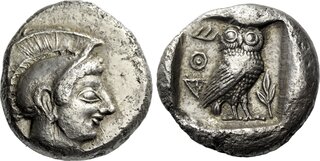| Numismatica Ars Classica > Auction 146 | Auction date: 8 May 2024 |
| Lot number: 2185 Price realized: This lot is for sale in an upcoming auction - Bid on this lot  | Show similar lots on CoinArchives Find similar lots in upcoming auctions on |
| Lot description: Attica, Athens. Tetradrachm, Civic mint circa 510-500/490, AR 26 mm, 16.85 g. Head of Athena r., wearing earring and crested Attic helmet decorated with tiny spiral on the back of the bowl. Rev. AΘE Owl standing r., head facing; in r. field, olive sprig. All within incuse square. Seltman Group L, 328. Svoronos pl. 6, 7. Extremely rare and an issue of great importance. A portrait of enchanting beauty of superb archaic style struck in high relief. Lovely light iridescent tone, obverse slightly off-centre, otherwise extremely fine Ex Harlan J. Berk Buy or Bid 197, 2016, 88; Harlan J. Berk Buy or Bid 208, 2019, 3; Harlan J. Berk Buy or Bid 210, 2020, 60 and Harlan J. Berk Buy or Bid 213, 2020, 78 sales. From the Heinz Kowalski collection (Brussels 1970s). This coin belongs to a critical period of Athenian history that ultimately had a lasting impact on the course of Western history in general. Although the famous Athenian civic types of Athena and her owl were probably introduced already under the late Peisistratid tyrants, the present tetradrachm was struck during the struggle of the Athenians to end the tyranny in their city once and for all. It was already clear that the tyranny had lost much of its former popularity in Athens when Hipparchus, the brother of the tyrant Hippias, was murdered by Harmodius and Aristogeiton in c. 514 BC. The death of his brother seemed to push Hippias over the edge psychologically and thereafter he became the stereotypical tyrant - the Greek term tyrannos simply means an extraconstitutional strong-man without the negative connotations that "tyrant" always has in English. Hippias became a harsh ruler who executed his political opponents and even looked to Persia for aid in crushing his opponents in Athens. The civic unrest that the excesses of Hippias inspired was soon focused by the powerful Alcmeonid clan of Athens in an attempt to force Hippias out of the city. With the support of Cleomenes I and the Spartan army (Sparta was traditionally hostile to the rule of tyrants - in 510 BC Hippias was forced to leave Athens. Once he had been removed and after a brief oligarchic period, in 508-507 BC the political reforms were introduced by Cleisthenes that established Athenian democracy. Hippias, however, had not quite given up on returning to power at Athens. In 490 BC, he assisted the Persian forces sent by Darius I of Persia to chastise the Athenians for their previous support for the rebels in the Ionian Revolt. Unfortunately for him, the Persians met the Athenians in battle at Marathon and were soundly defeated. The age of tyrants was fully over and that of radical Athenian democracy was dawning. Estimate: 35000 CHF |  |



